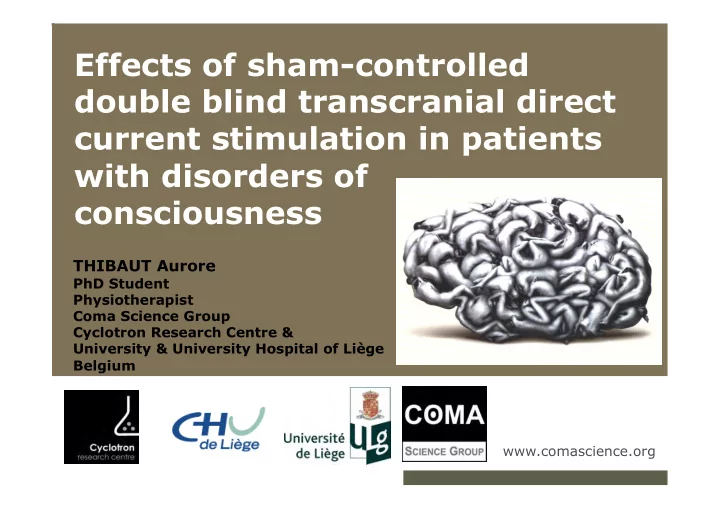

Effects of sham-controlled double blind transcranial direct current stimulation in patients with disorders of consciousness THIBAUT Aurore PhD Student Physiotherapist Coma Science Group Cyclotron Research Centre & University & University Hospital of Liège Belgium www.comascience.org
disorders of consciousness | behavioural evaluation | electrophysiology | neuroimaging | methods, ethics & quality of life | perspectives Introduction | Materials and Methods | Results | Discussion | Perspectives AIM of the study Assessing the effect of transcranial direct current stimulation (tDCS) on cognition in patients with disorder of consciousness In a double blind sham controlled randomized study www.comascience.org
Introduction | Materials and Methods | Results | Discussion | Perspectives Why direct current stimulation? Stimulation Population Effects Authors Prefrontal Healthy subjects Memory Marshall et al, J cortex Neurosci 2004 Alzheimer’s Memory Ferrucci et al, patients Neurology 2008 Stroke patients Attention Jo et al, Am J Phys Med Rehabil 2009 Aphasic patients Language Baker et al, Stroke 2010 • Non-invasive • Easy to apply • Cheap equipment www.comascience.org
Introduction | Materials and Methods | Results | Discussion | Perspectives Methods Anode Cathode Randomised Direct current double blind 2 mA sham controlled 20 minutes www.comascience.org
Introduction | Materials and Methods | Results | Discussion | Perspectives Methods CRS-R CRS-R CRS-R CRS-R tDCS tDCS 20’ 20’ 24h Responder : CRS-R post tDCS > pre-tDCS > sham > pre-sham Statistics : Stata 10.0 ANOVA Wilcoxon signed-rank test Giacino, Arch Phys Med Rehabil 2004 Stata 10.0 (StataCorp. 2007. Stata Statistical Software: www.comascience.org Release 10. College Station, TX: StataCorp LP)
Introduction | Materials and Methods | Results | Discussion | Perspectives Population 55 patients (16 women) 25 VS/UWS, 30 MCS aged 43 ± 18 y 25 traumatic / 30 non-traumatic 20 acute / 35 chronic (>3 months post insult) www.comascience.org
Introduction | Materials and Methods | Results | Discussion | Perspectives Group data (n=55) * * N=55 17 responders CRS-R total scores • 2 UWS; acute • 15 MCS; 7acute/8chronic PRE POST PRE POST tDCS sham www.comascience.org
Introduction | Materials and Methods | Results | Discussion | Perspectives Group data (n=55) * * 17 responders CRS-R mean scores • 2 UWS; acute • 15 MCS; 7acute/8chronic PRE POST PRE POST tDCS sham www.comascience.org
Introduction | Materials and Methods | Results | Discussion | Perspectives UWS/UV vs MCS MCS (n=30) VS/UWS (n=25) * * CRS-R mean scores PRE POST PRE POST tDCS tDCS www.comascience.org
Introduction | Materials and Methods | Results | Discussion | Perspectives Responders: audition subscale * * Consistent movment to command Reproducible movment to command Localisation of sounds Auditory sartle None PRE POST PRE POST tDCS sham www.comascience.org
Introduction | Materials and Methods | Results | Discussion | Perspectives Responders: motor subscale * * Functional use of objects Automatic motor reaction Object manipulation Localization of noxious stimulation Flexion withdrawal Abnormal posturing None PRE POST PRE POST tDCS sham www.comascience.org
Introduction | Materials and Methods | Results | Discussion | Perspectives Responders: communication * * Functional communication Intentionnal communication None PRE POST PRE POST tDCS sham www.comascience.org
Introduction | Materials and Methods | Results | Discussion | Perspectives tDCS presumed mode of action Short term effects Modification of neuronal excitability (action potential) Long term effects Action on opening of ion channels (Na + , Ca 2+ ) Increase NMDA receptors excitability improve neuron excitability Nitsche et al., J Physiol 2000 Nitsche et al., Neuroscientist 2010 www.comascience.org
Introduction | Materials and Methods | Results | Discussion | Perspectives Neuroimagery Prefrontal stimulation Improvement of DMN connectivity (MRI) Increase of regional electrical activity in the PF and AC cortexes (EEG) ( ß and δ / θ ) Motor stimulation rCBF increase in the left M1, right prefrontal cortex, right S1 (PET-scan) Functional connectivity increased within premotor, motor and sensorimotor areas (EEG) Keeser et al., J Neurosci, 2011 Lang et al., Eur J Neurosci, 2005 Keeser et al., Neuroimage, 2011 Polania, Nitsche and Paulus, HBM, 2010 www.comascience.org -
disorders of consciousness | behavioural evaluation | electrophysiology | neuroimaging | methods, ethics & quality of life | perspectives Introduction | Materials and Methods | Results | Discussion | Perspectives tDCS – advantages DBS and Amantadine improve cognitive functions of patients with disorder of consciousess But invasive and pharmacological tDCS improve cognition of patients in minimally conscious state without risk of brain damage or seizure Schiff et al., Nature 2008 Giacino et al., New Eng J Med, 2012 www.comascience.org Thibaut et al., in prep
Introduction | Materials and Methods | Results | Discussion | Perspectives tDCS critisisms Limitations: Short term effect Moderate clinical changes Superficial effect Improve electrode position www.comascience.org
Introduction | Materials and Methods | Results | Discussion | Perspectives tDCS – long term Effects last ± 90 minutes Short improvement Back to initial state Daily stimulations (5days) improvement and extension of benefits Hummel et al., Lancet 2006 www.comascience.org Antal et al., J Pain Symptom Manage 2010
Introduction | Materials and Methods | Results | Discussion | Perspectives tDCS – long term 1 week 1 week Prospective, randomized, controlled and double-blind study www.comascience.org
Introduction | Materials and Methods | Results | Discussion | Perspectives tDCS - M1 Cognitive effects + Motor effects ? Parameters: 1. Behavioral 2 mA – 20 min assessments: Anode: M1 CRS-R & Ashworth Cathode: supraorbicular 2. TMS : MEP & controlateral cortex motor threshold Lang et al., 2004 Bohannon and Smith, 1987 www.comascience.org
Introduction | Materials and Methods | Results | Discussion | Perspectives tDCS – M1 www.comascience.org
Introduction | Materials and Methods | Results | Discussion | Perspectives tDCS – neurophysiology 1. Comparison of the results with: cortical lesions (MRI) cerebral metabolism (PET-scan) Stimulation of preserved or damaged cortex? 2. EEG brefore and after tDCS Better understanding of neurophysiological effect of tDCS www.comascience.org
Introduction | Materials and Methods | Results | Discussion | Perspectives Conclusion tDCS improves cognition in minimally conscious state patients both acute and chronic; traumatic and non traumatic Future studies: 1. long term tDCS 2. tDCS on M1 3. neurophysiological effects www.comascience.org
Recommend
More recommend